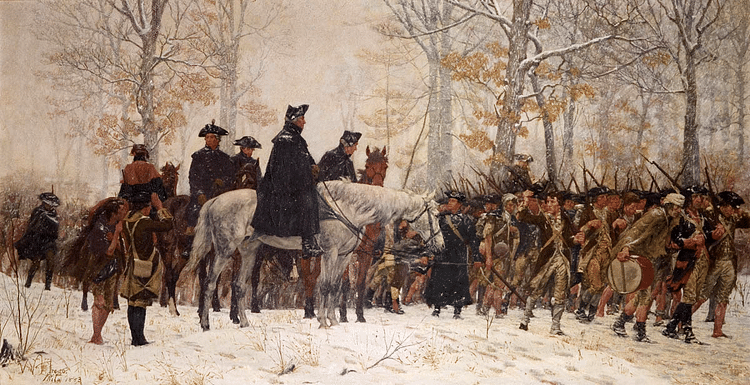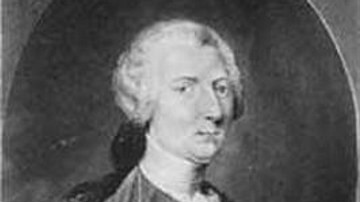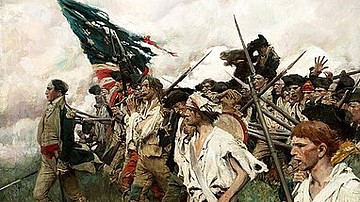
Valley Forge was the winter encampment of the Continental Army from 19 December 1777 until 18 June 1778, during one of the most difficult winters of the American Revolutionary War (1775-1783). Despite being undersupplied, underfed, and plagued with disease, the Continental Army underwent significant training and reorganization at Valley Forge, emerging as a much more disciplined and effective fighting force.
The Philadelphia Campaign
On 19 December 1777, the exhausted and starving soldiers of the Continental Army staggered into Valley Forge, Pennsylvania, a location about 18 miles (29 km) northwest of Philadelphia at the confluence of the Valley Creek and the Schuylkill River. It had been a long and difficult campaign. Four months earlier, they had raced down from New Jersey to defend the US capital of Philadelphia from the British army, only to be outflanked and defeated at the Battle of Brandywine (11 September). Following their victory, the British captured Philadelphia, which the Second Continental Congress had only just evacuated. The Continental Army regrouped and, on 4 October, retaliated with a surprise attack on a British garrison at the Battle of Germantown. Although the assault initially got off to a good start, a thick fog caused cohesion between American military units to break down, and the attack quickly lost momentum. When the British counterattacked, the undertrained Continental soldiers broke and fled. For the next two months, the two armies nervously maneuvered around one another. Although several bloody skirmishes were fought, neither side was eager to provoke another major battle.
Gradually, the temperatures dropped, and the bitter December winds signaled that it was time to suspend the campaign and enter winter quarters. The British army moved into Philadelphia, where the officers settled into the abandoned homes of the city's Patriot leaders and spent the winter attending lavish dinners, dancing at elegant balls, and courting Loyalist women. The Continental Army, meanwhile, marched to Valley Forge. The spot had been carefully chosen by the American commander-in-chief, General George Washington, for several reasons. First, its proximity to Philadelphia would allow the Americans to keep a close eye on the British army; attempts by the British to raid the surrounding Pennsylvanian countryside or to march for the town of York, the temporary seat of the Continental Congress, could quickly be challenged. Second, an encampment at Valley Forge would be easy to defend. The camp itself was to be situated on a large plateau surrounded by a series of hills and dense forests, creating a sort of natural fortress. Lastly, the location was beneficial because it was close to a supply of fresh water from the Valley Creek and Schuylkill River, and the abundance of nearby trees could easily be cut down for fuel or to build shelters.
Over 11,000 Continental soldiers filed into Valley Forge on that December day, accompanied by 500 women and children. They were certainly a disheveled lot. The many marches and countermarches they had needed to perform in the last several months had worn down their footwear; now, an estimated one out of every three Continental soldiers went entirely without shoes. Additionally, many soldiers lacked adequate coats to protect against the elements, particularly the incessant rain that had been falling all autumn. Many men owned only one shirt, while others did not even have a single shirt at all. It is unsurprising then that many of these exposed soldiers were already ill when they arrived at Valley Forge; out of the 11,000 men that arrived, only 8,200 were fit for duty.
The situation was made worse by a dangerous lack of food. At the beginning of the Valley Forge encampment, the army's commissary only had 25 barrels of flour, a small supply of salt pork, and no other stores of meat or fish. A lack of sufficient food and clothing was fairly typical of the army's supply department, which had often performed below expectations since its founding in 1775, but the chaos of the recent campaign had only made things worse. In its hurried evacuation from Philadelphia, Congress had failed to ensure the army's supply chain would remain unbroken, thereby contributing to the bareness of the army's food and clothing stores. Thus, it was clear from the start that the coming winter would be a challenging one.
Making Camp
The army's first priority upon arrival at Valley Forge would have to be the building of shelters. A small, industrial community that centered around the smelting of iron, Valley Forge did not have nearly enough buildings to accommodate the entire army. Luckily, the surrounding forests offered more than enough wood for the construction of huts. Officers picked out the precise spots upon which each hut would be built, carefully arranging the plots to form a neat grid with parallel streets and avenues. Each hut measured 16 feet by 14 feet (c. 4.8 x 4.2 m) and was constructed out of logs, the sides sealed with clay. Roofs were made of a variety of materials, usually thatched straw or brush, and most huts had dirt floors. Most of these structures housed twelve soldiers, although officers only had to share their huts with three or four other men. Scholars estimate that somewhere between 1,300 and 1,600 log huts were built at Valley Forge between 19 December 1777 and 13 January 1778. As Marquis de Lafayette observed, Valley Forge was transformed into "a small city of wooden huts" (Unger, 58).
General Washington himself stayed in a small tent until all the huts had been finished, at which point he moved into the two-story stone house that had been marked out for his headquarters. His aides moved in with him, as did his wife, Martha Washington, who had left the comfortability of Mount Vernon to play host to the myriad of politicians and military officers visiting the army camp. Martha's presence kept spirits high within the headquarters, giving visitors the impression that everything was under control. In reality, the situation remained quite dire. The army's already limited food store had continued to dwindle, leaving soldiers with nothing to eat but firecakes, a tasteless mixture of flour and water baked over a campfire. Washington had sent commissaries out as far as New Jersey and Delaware to purchase provisions, but most farmers would not accept the nearly worthless 'Continental currency' that the American officers tried to use. They much preferred selling their goods to the British, who paid with hard currency. Whatever foodstuffs the commissaries managed to procure often spoiled by the time they got back to Valley Forge due to transportation issues or the unreliability of the army's supply department.

Consequently, the situation only worsened. Before long, even the supply of firecakes was running out, leading Washington to despair on 16 February that the army was experiencing a 'famine' (Middlekauff, 420). Hundreds of troops were weakened from malnutrition, which, in turn, left them more susceptible to disease. Typhoid and dysentery ravaged the encampment, spreading through contaminated food or water, while other illnesses like pneumonia, typhus, and influenza were also common. Smallpox, too, was an ever-present threat, the outbreak of which could ravage the army. During the six months that the army spent at Valley Forge, over 2,000 men and 2,500 horses would ultimately die, from malnutrition, disease, exposure, or some combination of the three. The scent of death hung heavy over the camp, while for the living, the suffering continued. "The soldiers lived in misery," the Marquis de Lafayette would later recall. "They lacked for clothes, hats, shirts, shoes; their legs and feet black from frostbite – we often had to amputate" (Unger, 58).
Although numerous American officers resigned during these trying months, the desertion rate amongst regular soldiers remained roughly the same as it had been prior to Valley Forge. But while many soldiers were able to endure disease and starvation, they found it more difficult to deal with the suffocating boredom of the encampment. After the soldiers had finished constructing the huts, there was little for them to do except forage for food and wait for the winter to end. As a result, the men grew restless, and some of them got off to mischief. Some men alleviated their boredom by having shooting competitions, thereby wasting precious ammunition. Others adopted more nefarious hobbies, such as robbing the homes of nearby farmers.
General Washington was horrified by reports of these robberies, which he referred to as "base, cruel, and injurious to the cause in which we are engaged" (Middlekauff, 420). He responded by tightening discipline. Men were no longer allowed to carry muskets unless they were on duty. Nor were soldiers allowed to leave camp without a pass; men caught outside camp without a pass were liable to be imprisoned in their huts. Musters were held more frequently, and officers were authorized to conduct surprise inspections of huts to search for stolen goods. These disciplinary measures helped save the army from devolving into anarchy. But if the army were to be rescued from starvation, something more would have to be done.
Provisions & Conspiracies
On 23 December 1777, Washington wrote a letter to Henry Laurens, president of the Continental Congress, expressing his fear that "this Army might dissolve" if no steps were taken to fix the supply department. Washington knew that he had to tread lightly when appealing to Congress for help. His cautious command style, as well as his recent failure to defend Philadelphia, had led many congressmen to lose faith in his leadership capabilities; indeed, a loose conspiracy of politicians and military officers, retroactively referred to as the Conway Cabal, was plotting to remove Washington from command of the Continental Army. Washington was aware of the cabal and knew that he had to reinspire confidence in his abilities, but before anything else, he had to ensure the survival of his men.
Congress responded to Washington's concerns by recommending that he simply requisition the supplies he needed from the local population of farmers. The general was hesitant to comply with this suggestion, believing it would turn the local population against the Patriot cause. But, as the winter wore on and supply issues failed to improve, Washington realized he had no other choice. He sent officers to requisition hay, livestock, and other supplies from farmers but ordered the officers to leave enough behind so that the farmer could make it through the winter. The farmers were even allowed to have a say in which of the livestock the officers took and were presented with a receipt so that they could be financially reimbursed by Congress.
While this was enough to keep the army from dying of starvation, it was not a permanent solution. Washington knew he needed to reform the ineffective supply department, which would require congressional support. On 24 January, he invited a five-man congressional delegation to visit Valley Forge and assess the army's condition for themselves. Headed by Francis Dana of Massachusetts, the delegation was hosted by Martha Washington and shown around the camp by the general himself; the delegation therefore got a firsthand view of both the soldiers' suffering and their resilience. Dana was convinced as to the direness of the situation and, upon returning to York, became one of Washington's strongest supporters. He oversaw the reformation of the supply department, ensuring that each of the general's recommendations were carried out. Washington was back in Congress' favor, and all support for the Conway Cabal broke down.
As part of the supply reforms, Washington was allowed to select the new Quartermaster General. In March, he appointed Nathanael Greene, one of his most trusted subordinates, to this position. Initially, Greene was reluctant, believing he was better suited to a field command than an administrative position. But Washington was insistent, and Greene settled into his new role, only to find that he was well-suited for it, indeed. He organized foraging parties that were sent far and wide in search of food. One such party, led by General Anthony Wayne, was sent into New Jersey, while another, led by Colonel Henry 'Lighthorse Harry' Lee, scoured eastern Maryland and Delaware; each group turned up lots of hay, livestock, and horses, which were sent back to the army. The onset of spring improved the conditions of the roads, and any perishable items that turned up made it back to the encampment without spoiling. Greene continued to improve the efficiency of the supply department and even procured enough clothing for the soldiers. By the end of March, the food crisis was over, and Greene would continue to serve as Washington's capable Quartermaster General for the next two years.
Training the Troops
By March 1778, the supply issues were taken care of, discipline had been enforced, and the threat to Washington's position was over. Washington had even managed to reduce the threat of smallpox to the encampment by ordering about 4,000 of his men to get inoculated against the disease (inoculations being the precursor to vaccines). Now that the army was relatively healthy and in high spirits, it could shift its focus to training. This had long been a weak spot of the Continental Army, which had no standardized drill practices. Regimental commanders would instruct and drill their troops in any way they saw fit; considering that most regimental commanders had little to no formal military training, these drills were often ineffective. Luckily for the Continentals, the ideal drillmaster had just arrived at Valley Forge.
Baron Friedrich Wilhelm von Steuben was a lifelong soldier; having enlisted in the Prussian army at the age of 17, he fought in several battles during the Seven Years' War (1756-1763) and even served as an aide to King Frederick the Great of Prussia. He had been searching for employment with foreign armies when he encountered Benjamin Franklin in Paris, who had recommended him to the Continental Congress; Congress, in turn, sent him on to Valley Forge, where he arrived on 23 February 1778. Steuben spoke no English and could only communicate with the Continental officers in broken French but still managed to impress Washington with his military exploits. Washington decided to take a chance on the Prussian officer and granted him a temporary commission as Inspector General of the Continental Army, tasking him to train the Continental soldiers.

Steuben was given a model company of 100 men. The idea was that Steuben would instruct these 100 men who would, in turn, each go on to instruct another group of soldiers. The baron taught the Americans how to march in formation, handle their weapons, and effectively use the bayonet. He showed them better techniques for firing in volleys and how to shift formation while under fire. The training was greatly effective; the Continentals were eager to learn and were, moreover, happy to finally have something to do. Training sessions with the baron could also be rather entertaining; although Steuben had memorized the necessary English commands, his rough accent often caused confusion among the troops, leading the short-tempered baron to burst into a tirade of frustrated swearing. This amused the Americans, who found themselves endeared by the immaculately dressed Prussian officer with the bad temper; at one point, Steuben's translator, Captain Benjamin Walker, began translating the baron's swears into English, to the delight of the soldiers.
Leaving the Camp
By May 1778, the Continental Army was in high spirits. News of the recently formalized French alliance caused jubilant celebrations. Many soldiers were itching to put their new training to the test and begged their officers to let them attack the British. They would have their chance on 18 May, when Washington sent Lafayette and 2,200 troops to occupy Barren Hill, a location halfway between Valley Forge and Philadelphia where they could better watch British movements. The British noticed the Americans and, on 20 May, sent 5,000 men toward Barren Hill to wipe them out. However, Lafayette was able to move his men off the hill before a significant engagement could be fought. The speed and maneuverability with which the men marched away from the hill was a testament to their training.

A month later, the British army began its evacuation of Philadelphia; the Franco-American alliance had made their position there untenable, and the British ministry had decided to concentrate their forces at New York City. Washington decided to pursue, packing up camp and leaving Valley Forge on 18 June 1778, almost exactly six months after first arriving. On 28 June, the Continental Army engaged the British at the Battle of Monmouth; though the battle was tactically inconclusive, the Continentals stood their ground for over five hours of nonstop fighting in scorching heat, another example that their Valley Forge training had paid off.
Conclusion
Contrary to popular belief, the winter that the Continental Army spent at Valley Forge was relatively mild in terms of temperature; the coldest winter would not come until 1779-80 at Morristown, New Jersey, when the army would experience near constant snow and freezing temperatures. However, Valley Forge was arguably the most important winter. The army survived existential threats such as hunger and disease; the supply department was reformed and placed under the capable supervision of Nathanael Greene; Washington fended off the Conway Cabal and retained command of the army; and the army underwent much-needed reorganizing and retraining, under the guidance of Baron von Steuben. Without the experiences of Valley Forge, it is questionable whether the army would have survived to secure the final victory at the Siege of Yorktown, making it one of the most critical moments of the American Revolution.













